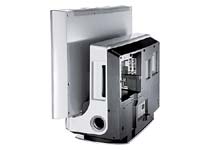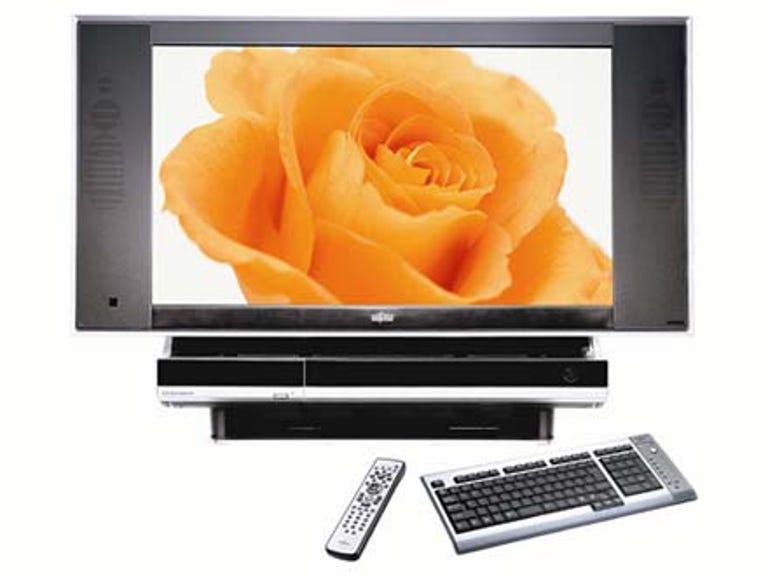 Why You Can Trust CNET
Why You Can Trust CNET Fujitsu Deskpower TX review: Fujitsu Deskpower TX
Fujitsu's Deskpower TX is an enticing offering for those moving up to both Media Center and LCD displays, but it's not without its weaknesses.
Design
The Good
The Bad
The Bottom Line
 Deskpower TX side view (click for larger image) |
The display on the Deskpower TX is a 32 inch (82 cm) LCD display that sits just above the PC itself. The great thing about the visual design is that you could easily miss the fact that there's a PC there at all, as it looks more or less just like the stand for the flat panel. Lifting the Deskpower TX will quickly disabuse you of that notion -- it's heavy at 42kg, and its weight and physical dimensions make it totally unsuitable for wall mounting. The direct inputs at the front are hidden behind a white panel, including the DVD tray, while the back of the Deskpower has a more "traditional" PC look to it, although the majority of ports are hidden away in a minor alcove at the back. That's good for keeping them discrete, although it does introduce some problems if you're constantly needing to plug in new devices.
Fujitsu also supplies IR sender/receiver units for relaying signals to suitable digital set top boxes, as well as a fairly standard Windows Media Center remote control, a wireless keyboard and mouse. The keyboard we received with our review unit was notable mostly because it was clearly a Japanese model, right down to Japanese Kanji alongside the Roman alphabet on each key. Whether that's present on the final retail keyboards is anyone's guess -- but it does help the keyboard stand out.
Features
Audio on the Deskpower TX comes via a pair of 5W speakers on the sides of the display, along with a 10W Sub-Woofer. That's likewise on the weaker side of the audio equation, although there's always the possibility of sending out audio to a better 5.1 audio subsystem. Getting one to work in well with the Deskpower TX's design aesthetic could be a touch tricky, however.
On the TV side, the Deskpower TX is remarkable both for what it does ship with, and what it omits. The two onboard TV tuners are a great inclusion, as they easily allow you to watch and record programs simultaneously, and both include additional inputs for composite and S-Video connections. The omission comes in the form of no integrated digital tuner -- in order to get the best out of the Deskpower TX you're going to have to match it up to at least one external set top box. Additionally, there's no inputs for anything better than S-Video, so those with aspirations of hooking up other digital sources, or consoles such as the Xbox 360 would have to put up with less than optimal picture quality in order to do so.
On the software side, the Deskpower TX runs on Windows XP Media Center Edition. One interesting software offering within the Deskpower TX is an application that allows you to directly connect games consoles to the LCD display. That might not seem like much of an offering, until you realise that the Media Center OS tends to buffer several seconds of display "in case". For video and even live TV that's rarely a problem, but playing games, where a two second gap between the visuals and your control response will always end in bloody pixellated annihilation, it's a huge issue.
Performance
The other major omission also crops up rather quickly in the fact that the unit lacks an integrated digital tuner. Analogue TV signals were received reasonably well, but there's nothing to make a good screen seem average than the kinds of ghosting and reception problems that you can all too easily get with an analogue signal. Adding a digital set top box is a relatively trivial matter, and the Deskpower TX does come with IR dongles to allow you to control a digital STB via the media center remote. The problem here is a visual one, as the Deskpower TX is both large and more or less visually complete; adding an additional box creates both a space and aesthetic problem.
It's hard not to get excited about the Deskpower TX, both from a design and conceptual standpoint. It's not the world's greatest PC -- and we suspect some hearty hacking could turn it into a much, much better unit -- but as an entry-level jump up from both a standard PC and a standard definition CRT display it's an excellent option.


